| Listing 1 - 10 of 10 |
Sort by
|
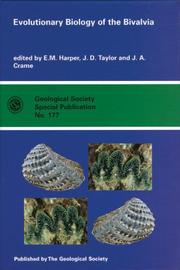
ISBN: 189779911X 1862390762 9781897799116 9781862390768 Year: 1994 Publisher: London : Geological Society of London,
Abstract | Keywords | Export | Availability | Bookmark
 Loading...
Loading...Choose an application
- Reference Manager
- EndNote
- RefWorks (Direct export to RefWorks)
Issue --- Bivalves --- Acephala --- Aglossa --- Anodontoda --- Bivalvia --- Conchifera --- Conchophora --- Cormopoda --- Dithra --- Elatobranchiata --- Elatocephala --- Eulamellibranchia --- Lamellibranchia --- Lamellibranchiata --- Lipocephala --- Pelecypoda --- Teleodesmacea --- Tropipoda --- Mollusks --- RBINS-REPRINT --- Evolution --- Offprints
Book
ISBN: 1634851404 9781634851404 9781634851237 Year: 2016 Publisher: Hauppauge, New York
Abstract | Keywords | Export | Availability | Bookmark
 Loading...
Loading...Choose an application
- Reference Manager
- EndNote
- RefWorks (Direct export to RefWorks)
Fishery products --- Bivalves --- Acephala --- Aglossa --- Anodontoda --- Bivalvia --- Conchifera --- Conchophora --- Cormopoda --- Dithra --- Elatobranchiata --- Elatocephala --- Eulamellibranchia --- Lamellibranchia --- Lamellibranchiata --- Lipocephala --- Pelecypoda --- Teleodesmacea --- Tropipoda --- Mollusks --- Aquatic resources --- Inspection --- E-books
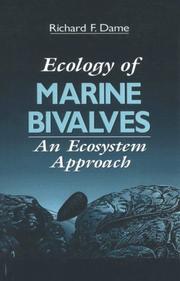
ISBN: 1003040888 142004978X 0849380456 Year: 1996 Publisher: Boca Raton : CRC Press,
Abstract | Keywords | Export | Availability | Bookmark
 Loading...
Loading...Choose an application
- Reference Manager
- EndNote
- RefWorks (Direct export to RefWorks)
Bivalves, such as clams and oysters, are species having two-valved shells. In the marine ecosystem these species play a unique and essential role. This book examines the ecology of bivalves from an ecosystem or holistic view, taking into consideration their processes, interactions, and components. Studies of bivalves at the physical, organismic, and population levels are presented as foundations for understanding ecosystem processes. Ecology of Marine Bivalves: An Ecosystem Approach explores the potential use of bivalves as indicators and monitors of ecosystem health and describes experiments from the perspective of computer simulations, mesocosm studies, and field manipulation experiments. The theories of many areas of science support the various approaches. Concise reviews and more than 70 tables and figures give you rapid access to synthesized data about these keystone species.
Bivalvia --- Zoology --- Health & Biological Sciences --- Invertebrates & Protozoa --- Ecology --- Acephala --- Aglossa --- Anodontoda --- Conchifera --- Conchophora --- Cormopoda --- Dithra --- Elatobranchiata --- Elatocephala --- Eulamellibranchia --- Lamellibranchia --- Lamellibranchiata --- Lipocephala --- Pelecypoda --- Teleodesmacea --- Tropipoda --- Mollusks
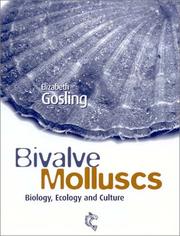
ISBN: 0852382340 9780852382349 Year: 2003 Publisher: Oxford Fishing News Books
Abstract | Keywords | Export | Availability | Bookmark
 Loading...
Loading...Choose an application
- Reference Manager
- EndNote
- RefWorks (Direct export to RefWorks)
Bivalves --- Bivalve culture --- Bivalve culture. --- Bivalves. --- Zoology and Animal Sciences. Biology of Animal Taxonomic Groups --- Mollusca --- Mollusca. --- Acephala --- Aglossa --- Anodontoda --- Bivalvia --- Conchifera --- Conchophora --- Cormopoda --- Dithra --- Elatobranchiata --- Elatocephala --- Eulamellibranchia --- Lamellibranchia --- Lamellibranchiata --- Lipocephala --- Pelecypoda --- Teleodesmacea --- Tropipoda --- Mollusks --- Mollusk culture
Book
ISBN: 0813711258 Year: 1970 Publisher: Boulder : Geological Society of America,
Abstract | Keywords | Export | Availability | Bookmark
 Loading...
Loading...Choose an application
- Reference Manager
- EndNote
- RefWorks (Direct export to RefWorks)
Bivalvia --- Adaptation (Biology) --- Environment --- Biology --- Self-organizing systems --- Variation (Biology) --- Biological fitness --- Genetics --- Acephala --- Aglossa --- Anodontoda --- Conchifera --- Conchophora --- Cormopoda --- Dithra --- Elatobranchiata --- Elatocephala --- Eulamellibranchia --- Lamellibranchia --- Lamellibranchiata --- Lipocephala --- Pelecypoda --- Teleodesmacea --- Tropipoda --- Mollusks --- Special issues --- Environmental adaptation --- Adaptation, Environmental
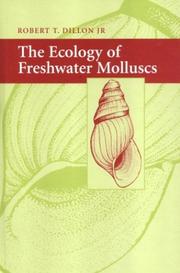
ISBN: 1107111501 0511052383 0511324987 0511173407 0511152450 0521359910 0511542003 9786610432059 1280432055 0511017286 9780511017285 0511037155 9780511037153 9780511152450 9780511052385 9780511173400 9780521352109 052135210X 9780511542008 9780521359917 Year: 2000 Publisher: Cambridge New York Cambridge University Press
Abstract | Keywords | Export | Availability | Bookmark
 Loading...
Loading...Choose an application
- Reference Manager
- EndNote
- RefWorks (Direct export to RefWorks)
This book provides a comprehensive review of the ecology of freshwater bivalves and gastropods worldwide. It deals with the ecology of these species in its broadest sense, including diet, habitat and reproductive biology, emphasising in particular the tremendous diversity of these freshwater invertebrates. Following on from these introductory themes, the author develops a life history model that unifies them, and serves as a basis for reviews of their population and community ecology, including treatments of competition, predation, parasitism and biogeography. Extensively referenced and providing a synthesis of work from the nineteenth century onwards, this book includes original analyses that seek to unify previous work into a coherent whole. It will appeal primarily to professional ecologists and evolutionary biologists, as well as to parasitologists.
Gastropoda --- Bivalves --- Freshwater invertebrates --- Aquatic invertebrates --- Freshwater animals --- Acephala --- Aglossa --- Anodontoda --- Bivalvia --- Conchifera --- Conchophora --- Cormopoda --- Dithra --- Elatobranchiata --- Elatocephala --- Eulamellibranchia --- Lamellibranchia --- Lamellibranchiata --- Lipocephala --- Pelecypoda --- Teleodesmacea --- Tropipoda --- Mollusks --- Gasteropoda --- Gastropods --- Ecology. --- Ecology
Book
ISBN: 0122369505 9780122369506 Year: 1977 Volume: 11 Publisher: New York, NY : Academic Press,
Abstract | Keywords | Export | Availability | Bookmark
 Loading...
Loading...Choose an application
- Reference Manager
- EndNote
- RefWorks (Direct export to RefWorks)
Bivalves --- Mollusks --- Lamellibranchiata --- -Freshwater invertebrates --- -Mollusks --- -Conchology --- Malacology --- Molluscs --- Aquatic invertebrates --- Acephala --- Aglossa --- Anodontoda --- Bivalvia --- Conchifera --- Conchophora --- Cormopoda --- Dithra --- Elatobranchiata --- Elatocephala --- Eulamellibranchia --- Lamellibranchia --- Lipocephala --- Pelecypoda --- Teleodesmacea --- Tropipoda --- -Identification --- Freshwater invertebrates --- Conchology --- Mollusca --- Bilateria --- Invertebrates --- Shellfish --- Freshwater animals --- Identification --- Bivalves - Great Britain - Identification --- Freshwater invertebrates - Great Britain - Identification --- Mollusks - Great Britain
Book
ISBN: 1283350289 9781420049787 1439839123 1439839093 042910653X 9786613350282 9781439839096 1000218791 Year: 2012 Publisher: Boca Raton : Taylor & Francis,
Abstract | Keywords | Export | Availability | Bookmark
 Loading...
Loading...Choose an application
- Reference Manager
- EndNote
- RefWorks (Direct export to RefWorks)
Exploring the potential use of bivalves as indicators and monitors of ecosystem health, this book describes live and computer simulated experiments, mesocosm studies, and field manipulation experiments. This second edition discusses major new developments, including phase shifts in many coastal and estuarine ecosystems dominated by suspension-feeding bivalves, the invasion or introduction of alien bivalve species, the rapid growth of environmental restoration focused on bivalves, and the examination of geological history with regard to global climate change and its impact on bivalve-dominated systems.
Bivalves --- Marine invertebrates --- Biotic communities. --- Ecology. --- Biocenoses --- Biocoenoses --- Biogeoecology --- Biological communities --- Biomes --- Biotic community ecology --- Communities, Biotic --- Community ecology, Biotic --- Ecological communities --- Ecosystems --- Natural communities --- Ecology --- Population biology --- Aquatic invertebrates --- Marine animals --- Acephala --- Aglossa --- Anodontoda --- Bivalvia --- Conchifera --- Conchophora --- Cormopoda --- Dithra --- Elatobranchiata --- Elatocephala --- Eulamellibranchia --- Lamellibranchia --- Lamellibranchiata --- Lipocephala --- Pelecypoda --- Teleodesmacea --- Tropipoda --- Mollusks
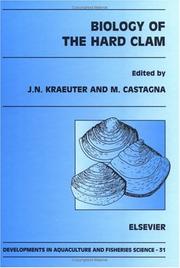
ISBN: 9780444819086 0444819088 9780080528014 0080528015 1281058149 9781281058140 9786611058142 6611058141 Year: 2001 Publisher: Amsterdam New York Elsevier
Abstract | Keywords | Export | Availability | Bookmark
 Loading...
Loading...Choose an application
- Reference Manager
- EndNote
- RefWorks (Direct export to RefWorks)
The hard clam, Mercenaria mercenaria, is an important commercial, recreational and ecological inhabitant of coastal bays along the east and gulf coasts of the United States. This title represents the first state of the art summary of existing knowledge of the hard clam by experts in various disciplines.Containing a compendium of literature on the hard clam, comprehensive chapters on various aspects of its biology as well as summaries of knowledge including the gray literature on this economically important species, this volume represents a comprehensive source of biological informatio
Northern quahog. --- Bivalves --- Acephala --- Aglossa --- Anodontoda --- Bivalvia --- Conchifera --- Conchophora --- Cormopoda --- Dithra --- Elatobranchiata --- Elatocephala --- Eulamellibranchia --- Lamellibranchia --- Lamellibranchiata --- Lipocephala --- Pelecypoda --- Teleodesmacea --- Tropipoda --- Mollusks --- Bay quahog --- Hard clam, Northern --- Hardshell clam --- Littleneck clam --- Mercenaria mercenaria --- Northern hard clam --- Poquauhock --- Quahaug --- Quahog, Bay --- Quahog, Northern --- Quahogs --- Quohaug --- Quohog --- Round clam --- Venus mercenaria --- Mercenaria --- Physiology.

ISBN: 1402030282 1402030290 9786610283187 1280283181 1402030304 Year: 2005 Volume: 47 Publisher: Dordrecht, Netherlands : Springer,
Abstract | Keywords | Export | Availability | Bookmark
 Loading...
Loading...Choose an application
- Reference Manager
- EndNote
- RefWorks (Direct export to RefWorks)
Animals are a major link between the water column (pelagic) and the bottom (benthic) habitats in most shallow systems. This coupling is dominated by active processes such as suspension-feeding in which the organism actively uses energy to pump water that is then filtered to remove suspended particles that are consumed while undigested remains are deposited on the bottom. As a result of this feeding on and metabolism of particles, the animals excrete dissolved inorganic and organic waste back into the water column, and thus, become major components in the cycling and feedback of essential elements. With relatively high weight specific filtration rates of 1— 10 liters/hour/gram dry tissue and a propensity to form large aggregated populations (beds, reefs, schools and swarms), these organisms can play an important role in regulating water column processes Although estuarine bivalve molluscs such as oysters and mussels dominate the suspension-feeder literature, other groups including plankton and nekton that are found in estuarine as well as other aquatic systems are also potentially important removers of suspended particles. Thus, a significant part of the NATO Advanced Research Workshop focused on suspension-feeders as controllers of plankton abundance, biomass and diversity, system metabolism, nutrient cycling and scale dependency. Systems dominated by suspension-feeders are typically impacted by human activities including recreation, aquaculture, human and industrial pollution, and bilge water from shipping. Suspension-feeders are often impacted by fisheries and over-exploitation. These impacts commonly result in changes in ecosystem structure either through the food chain concentration of harmful substances or diseases, the introduction of alien species of suspension-feeders, or the instability of suspension-feeders systems through species displacement or phase shifts in the dominance between different suspension-feeding components such as nekton or zooplankton. These issues were addressed near the close of the workshop along with conclusions and syntheses developed by the working groups.
Marine ecology --- Marine animals --- Ecologie marine --- Faune marine --- Congresses. --- Congrès --- Suspension feeders. --- Suspension feeders --- Estuarine ecology --- Freshwater ecology --- Earth & Environmental Sciences --- Zoology --- Health & Biological Sciences --- Animal Geography --- Ecology --- Bivalves --- Food --- Congrès --- EPUB-LIV-FT LIVBIOLO SPRINGER-B --- Acephala --- Aglossa --- Anodontoda --- Bivalvia --- Conchifera --- Conchophora --- Cormopoda --- Dithra --- Elatobranchiata --- Elatocephala --- Eulamellibranchia --- Lamellibranchia --- Lamellibranchiata --- Lipocephala --- Pelecypoda --- Teleodesmacea --- Tropipoda --- Marine fauna --- Ocean animals --- Sea animals --- Life sciences. --- Ecology. --- Biodiversity. --- Ecosystems. --- Life Sciences. --- Aquatic animals --- Marine organisms --- Mollusks --- Endangered ecosystems. --- Balance of nature --- Biology --- Bionomics --- Ecological processes --- Ecological science --- Ecological sciences --- Environment --- Environmental biology --- Oecology --- Environmental sciences --- Population biology --- Biological diversification --- Biological diversity --- Biotic diversity --- Diversification, Biological --- Diversity, Biological --- Biocomplexity --- Ecological heterogeneity --- Numbers of species --- Threatened ecosystems --- Biotic communities --- Nature conservation --- Ecology . --- Biocenoses --- Biocoenoses --- Biogeoecology --- Biological communities --- Biomes --- Biotic community ecology --- Communities, Biotic --- Community ecology, Biotic --- Ecological communities --- Ecosystems --- Natural communities
| Listing 1 - 10 of 10 |
Sort by
|

 Search
Search Feedback
Feedback About UniCat
About UniCat  Help
Help News
News